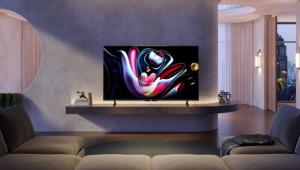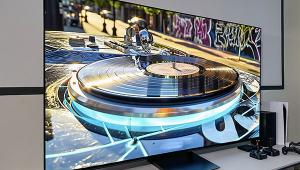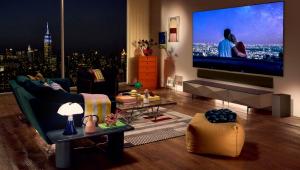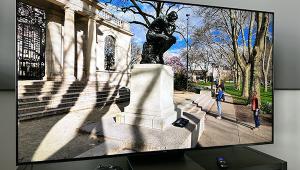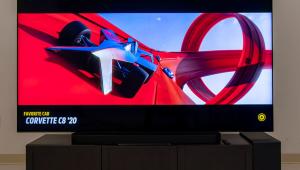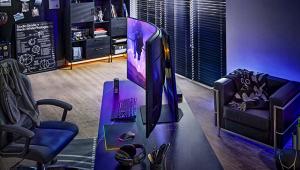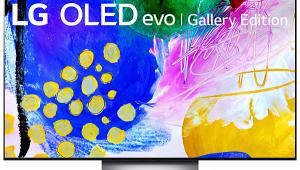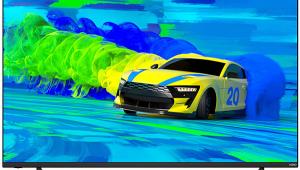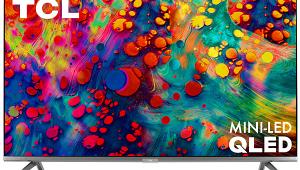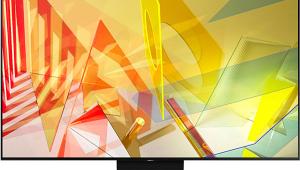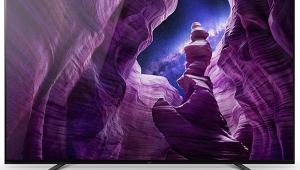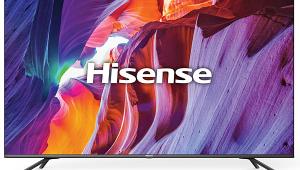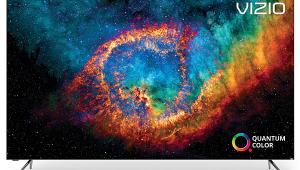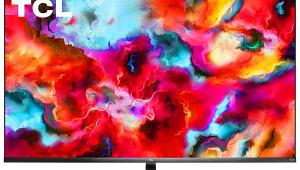LG OLED65C8PUA OLED Ultra HDTV Review Page 2
SDR Performance
The 65C8 easily passed all of our standard video tests. It also passed both Dolby Digital and DTS soundtracks in a full surround format from its optical digital audio output.
I spent several weeks watching the 65C8 using the ISF Dark Room mode’s default settings, modified only by a reduction of the OLED Light control. Color rendition was hard to fault. One of my favorite Blu-rays to check for natural color is Oblivion. Here, and with other Blu-rays as well, flesh tones looked believable. Other colors, from the desert sand to the vivid greens in Jack’s secret valley, gave me no cause for complaint. Resolution was superb, with the set’s Alpha 9 processor clearly doing a great job converting a 1080p source to fit the LG’s 2160p display.
 There have been complaints in the past about OLEDs revealing dark vertical streaks when displaying full-field near-black test patterns. These were present (but barely) on the LG E7 model I reviewed last year. On the 65C8, I did see a single, nearly invisible, streak, but it never appeared on actual program material. Another complaint has been that the deepest blacks on LG’s OLEDs appear subtly crushed. LG has consistently improved on this with each new generation of sets, and I now consider it to be a non-issue. When it comes to displaying deep blacks and shadow detail, I’d favor an OLED like the 65C8 over any other current technology.
There have been complaints in the past about OLEDs revealing dark vertical streaks when displaying full-field near-black test patterns. These were present (but barely) on the LG E7 model I reviewed last year. On the 65C8, I did see a single, nearly invisible, streak, but it never appeared on actual program material. Another complaint has been that the deepest blacks on LG’s OLEDs appear subtly crushed. LG has consistently improved on this with each new generation of sets, and I now consider it to be a non-issue. When it comes to displaying deep blacks and shadow detail, I’d favor an OLED like the 65C8 over any other current technology.
Did a full color calibration improve on the 65C8’s already pristine SDR performance? Absent two identical side-by-side samples, one calibrated and the other not, any improvement would be hard to spot. That doesn’t make calibration unnecessary, but in my experience recent top sets provide better out-of-the-box performance than in the past.
The 65C8 can handle motion as well as any competing flat-panel set I’ve reviewed over the past five years, though it doesn’t do it as well as long-departed plasma or old-timey CRT sets. If motion blur bothers you, particularly on sports or games where fast motion is common and the infamous soap opera effect is irrelevant, LG’s TruMotion feature is there to help. But since I strongly dislike the effect of any motion interpolation on movies (true for any post-plasma set I’ve reviewed) I left TruMotion off.
Do I need to mention off-axis viewing? While LCD sets are gradually making strides to improve in this area, only OLED offers near-ideal picture uniformity as far off from center-screen as you (or your family and guests) are likely to sit.
HDR10 Performance
Even out of the box, HDR10 programs were a pleasure to watch on the 65C8 in either the Cinema HDR or Technicolor HDR Picture Modes. They looked even better post-calibration, though the improvement was easier to spot with some material than others and was rarely dramatic. I turned on Dynamic Tone Mapping and used the Dynamic Contrast setting that worked best for the specific source and/or viewing condition. In my darkened room, this was most often either Off or Low.
In my 2017 review of the LG OLED65E7P, I remarked that the individual hairs on Jack’s stubble and the freckles on Victoria’s face were much easier to see than on the 1080p version when watching Oblivion. The same was true with the 65C8. Highlights and shadow details also stood out. One shot in the film’s opening montage that combines a collapsed structure in deep shadow with a bright sky above it appeared more lifelike in Ultra HD than on regular Blu-ray. Uniformly dark scenes with bright highlights, such as one where Jack investigates an underground library and a later sequence when he’s captured by the “Scavs,” also produced a more dramatic result than the same scenes in SDR.

Oblivion’s color is relatively natural and doesn’t knock you out when viewed in either SDR or HDR. For truly eye-popping UHD color, you can’t do better than Pixar’s Coco. The enhanced colors provided by the 65C8 were easy to spot in this animated film, but I saw them with live-action discs as well. Rich, saturated reds, in particular, can’t be equaled by standard HD’s Rec.709 color gamut.
OLED can’t as yet reach the peak luminance offered by the best LCD sets (and may never be able to), but the technology’s unequalled blacks allow the 65C8 to provide exceptional HDR performance. The bright lightning flashes in Oblivion as Jack maneuvers his copter through a thunderstorm; the elaborate, richly-staged musical numbers in The Greatest Showman; and just about all of Guardians of the Galaxy Vol.2 didn’t leave me wanting when it came to color, resolution, and high dynamic range impact.
Dolby Vision Performance
While I didn’t perform a Dolby Vision calibration for this review, that didn’t stop me from sampling several Dolby Vision titles on Ultra HD Blu-ray, including Gladiator, Jumanji: Welcome to the Jungle, and Braveheart. Each of those sources looked every bit as good on the LG as the HDR10 programs I watched. As always, the result was dependent on the quality of the original material. I can’t yet say whether or not Dolby Vision offers any distinct advantage over plain-vanilla HDR10 (or even HDR10 on a set like the 65C8 that can convert the static tone mapping of an HDR10 source to dynamic). But of the titles mentioned above, Braveheart made the deepest impression. It looked little short of spectacular on the LG, providing one of the most jaw-dropping viewing experiences I’ve had to date.
Conclusion
When I reviewed LG’s E7 OLED this time last year, I wondered if it was the perfect TV. Ultimately, the answer to that question is no, because the company’s new C8 model is even better. Not by much, however—LG’s changes for 2018 are evolutionary, not revolutionary. But if your budget allows it, and you don’t require the higher peak brightness that LCD UHDTVs provide, you’d be a fool not to give the 65C8 a very serious look.
- Log in or register to post comments


LG did a great disservice by essentially perfecting 3D on the 2016 model and then dropping it. The 3D is stunningly beautiful on the E6 OLED but not present on the C7 or C8. I bought two E6 models so I don't have to give up my 3D collection if one of them gives up the ghost. I wish LG would bring 3D back. People who have not seen 3D on an E6 (or G6) just have no idea what they are missing.

But it's not being supported for some reason. Even 3D movies in theaters are only 2K. For the foreseeable future 4K is in and 3D is out.

In my opinion 3D was the most overrated 'feature' of the AV world in the last 10 years. I'm not alone...hence the lack of support here.

Have you ever seen 3D on a 2016 OLED? I totally agree with you that 3D was poorly implemented before that, which accounts for its demise. However, I think if LG has properly promoted 3D on its OLED, that 3D TV could well have made a comeback. If showrooms has shown off the stunningly beautiful 3D on these OLEDs, people would have wanted it. But LG never promoted their outstanding 3D and had a pricing policy that actively discouraged 3D by not putting 3D on the lower priced B6 flatscreen but only on the C6 curved screen, and then LG concluded that there was no demand for 3D because people rejected the curved screen (having never seen or heard how good the 3D was). I think this is a tragic loss to the world and that LG could have revived 3D and created a large demand for it if they had actively marketed it.

Yeah, I know the 2018 C8 has slight improvements over its predecessors.
These are incremental improvements, not substantial.
The only worthwhile substantial improvement regarding OLED's is the price drop compared to 2015 outrageous prices.
The C8 pricing is acceptable.
Yet, keep in mind that in April of this year you could purchase a 2017 65"B7 for $2,300.
You have to spend hours in a completely dark room to appreciate the subtle differences between a B7 and C8 models.
If the room has substantial ambient light, you could not determine which one is the better model if your life depended on it.
Now if a 77"C8 could be had for $5,000 then that would be a must buy.

I wish your evaluation had included a test of the set's reset feature that is suppose to correct any image retention issue. For example, display a static image for some time period and then evaluate how much image retention occurred and whether it could be eliminated. I can't trust an untested system given the amount of static images that still show up frequently particularly when streaming music. I can't get myself to purchase a technology that makes me paranoid about ruining it every time I see a static image. Until I see your test results, I'm sticking with LCD TV's although I'd really like to purchase an OLED.

Hey Billy. A quick note on image retention...
I bought a 65" LG C7 in Dec of last year. Like yourself I was super paranoid about static images and getting screen burn-in/image retention. I can tell you that I have had zero issues...
I play a PS4 and as you know there are lots of static images gaming and I've never had an issue. What I do get is amazing picture quality...it's literally the best TV I've ever owned.
That said I am careful with static images and I don't leave a show paused and just walk away from it for any great length of time. Also, on a side note it annoys me how I've only got a few 4K channels in my cable package and they all insist on having their logo plastered to the screen. So far, zero issues with image retention so i say go for it!

I love watching musicals and different Broadway performances and this TV must be a great option for this aim! I used to check the tour of musicals on https://dearevanhansenshow.com/tour/ but now I can see all the plays sitting on my sofa.

